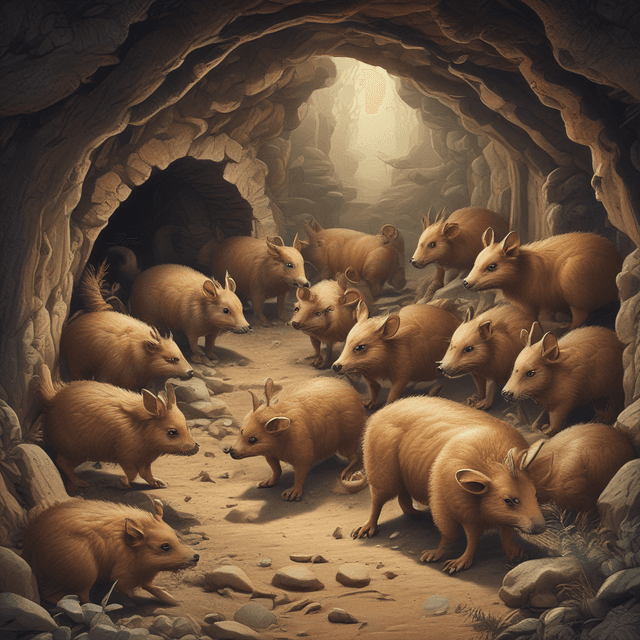
| Type | Large, social rodent |
| Ecology | Dominant herbivore |
| Habitat | Forests • Grasslands • Tundras |
| Behavior | Complex underground burrow networks |
| Distribution | North America • Eurasia |
| Cultural Significance | Hunted, domesticated and revered by indigenous human societies |
In this alternate world, the taxonomic order traditionally known as "deer" (Cervidae) does not exist. Instead, the ecological and cultural niche filled by deer in our reality is occupied by a family of large, highly social rodents known as "rodeer" (Castoroidea).
Rodeer first appeared during the Eocene epoch, evolving from a common ancestral species of rodents that inhabited the forests and grasslands of North America. Over millions of years, this ancestral rodent lineage grew significantly in size, developed more sophisticated social behaviors, and adapted specialized traits for grazing and burrowing.
By the Miocene epoch, rodeer had spread across much of Eurasia as well, becoming a dominant herbivore in many ecosystems. While physically distinct from true deer, rodeer were classified by early taxonomists as a unique family within the order Rodentia, the taxonomic group containing all rodent species.
The typical rodeer stands 3-5 feet tall at the shoulder and weighs between 300-800 pounds, making them substantially larger than any living rodent species. They have sturdy, barrel-shaped bodies with short, powerful limbs adapted for digging. Rodeer lack the distinctive antlers of true deer, but have large, ever-growing front incisors used for gnawing, as well as smaller molars for chewing vegetation.
Their fur coats vary in color from reddish-brown to grey, often with lighter patches. Rodeer also possess keen senses of smell, hearing and vision to detect predators within their vast underground burrow networks. Despite their size, they are generally herbivorous, feeding on grasses, leaves, roots, tubers and the occasional fallen fruit or nut.
Rodeer are highly social animals, living in large family groups or "colonies" that can number in the hundreds of individuals. They build complex, multi-chambered burrow systems, sometimes extending for miles underground, with separate areas for sleeping, foraging, nesting and raising young. Rodeer communicate using a diverse repertoire of vocalizations, scent markings and body language.
The colony is led by a dominant breeding pair, with the rest of the group composed of their offspring, other close relatives, and occasionally unrelated individuals that have joined the colony. Rodeer have an elaborate social hierarchy and engage in behaviors like allogrooming, food sharing and collective defense of the burrow system.
Rodeer are found across a wide range of habitats in North America, Eurasia and parts of North Africa, from the boreal forests of Siberia to the prairies of the Great Plains to the tundra of Greenland. They thrive in areas with deep, well-drained soils suitable for burrowing, as well as abundant vegetation for grazing.
Rodeer play a critical role in many ecosystems as a keystone herbivore, shaping the landscape through their burrowing and grazing activities. Their burrow systems provide shelter and nesting sites for numerous other species, from insects to small mammals. Conversely, rodeer are an important prey species for large carnivores like bears, wolves and big cats.
For many indigenous cultures across the Northern Hemisphere, rodeer have held great cultural and spiritual significance, rivaling the importance of true deer in our world. Rodeer have been hunted for meat, hides, bones and other materials used for tools, clothing and shelter. Their burrows were sometimes even incorporated into human dwellings.
In some regions, rodeer were also domesticated and used as beasts of burden, with their strength and burrowing abilities harnessed for agriculture and transportation. Depictions of rodeer appear prominently in the art, mythology and oral traditions of many ancient civilizations.
Today, rodeer remain an important part of the ecosystem and culture of numerous indigenous communities, even as their populations face threats from habitat loss, overhunting and competition with human agricultural activities. Their preservation is seen as crucial to maintaining the natural and cultural heritage of these regions.